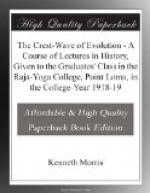What happened was this: in 320, one Chandragupta Gupta married the Pincess of Magadha; and an era was dated from their coronation on the 26th of February in that year. Their son Samudragupta succeeded his father in 326, and reigned until 375. It is characteristic of India that this, probably the greatest monarch since Asoka, is absolutely unmentioned in any history or contemporary literature: the sole evidence for his reign and greatness comes from coins and inscriptions. One of the latter is to be found on a pillar originally set up and inscribed by Asoka, now in the fort at Allahabad. It shows him a mighty conqueror, reigning over all Hindustan; victorious in the Deccan; and, by influence and alliances, dominant from Ceylon to the Oxus. His coins picture him playing on the lyre; the inscriptions speak of him as a poet and musician; in his reign began a great renaissance in art, architecture, literature, and perhaps especially in music,—a renaissance which reached its culmination in the reign of his successor. Another thing to note: when of old time Pushyamitra overturned the Buddhist Mauryas, he showed his Brahmin orthodoxy by performing the great Horse Sacrifice;—a sign that the ancient religion had come back in triumph. They let loose a horse to wander where it would, and followed it with an army for a whole year; then sacrificed it. Samudragupta performed the same rites;—and it is known that the Gupta age was one of strong reaction against Buddhism. I know that it is disputed now that there was ever a persecution of the Buddhists in India; but the tradition remains; and one of the Teachers, in a letter that appears either in the Occult World or Esoteric Buddhism, speaks of India as a land from which the Light of the Lodge had been driven with the followers of the Buddha. Certainly there were Buddhists in India long after this time: even a great Buddhist king in the seventh century: but it seems more than probably that the spirit of intolerance went east with the eastward cyclic flow we have noted this evening: from Christianity to Zoroastrianism: from Zoroastrianism under the Sassanids to Brahminism under the Guptas.
Not, perhaps, that there was actual persecution, yet. Emissaries from the king of Ceylon found the shrine at Buddhagaya fallen into decay; and they themselves were not well treated at the site. The Buddhist kind, however, determined to remedy things as well as he could. He sent ambassadors with rich gifts to Samundragupta; who called the gifts tribute, and permitted him, on consideration thereof, to restore the shrine. The monastery then built by the Sinhalese was afterwards visited by Hiuen Tsang; who describes it as having three storeys, six halls, three towers, and accommodation for a thousand monks. “On it,” says Hiuen Tsang, “the utmost skill of the artist has been employed; the ornamentation is in the richest colors, and the statue of Buddha is cast in gold and silver, decorated with gems and precious stones.”




